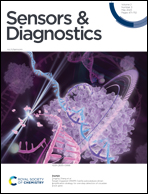An all-solid-state potentiometric microsensor for real-time monitoring of the calcification process by Bacillus subtilis biofilms†
Abstract
Bacillus subtilis, as a bacterium with wide-ranging applications, has been explored for CO2 sequestration using intracellular or extracellular carbonic anhydrase (CA). However, noninvasive, real-time monitoring of CA-mediated calcium carbonate precipitation processes is scarce, especially for bacteria in seawater. We report here the use of a carbon nanotube fiber-filled glass micropipette for preparing mechanically robust ion-selective microelectrodes for in situ ion sensing. Hydrophobic carbon nanotube fibers with remarkable electrical and mechanical properties can act not only as a transduction layer but also as a self-supporting material. As a model, an all-solid calcium ion-selective microelectrode (Ca2+-ISμE) with a size of 20 μm was designed. The Ca2+-ISμE shows a Nernstian response to Ca2+ in 0.5 M sodium chloride within the range of 1.0 × 10−6–1.0 × 10−2 M, and the detection limit is 4.0 × 10−7 M. The proposed microsensor allows for in situ, real-time monitoring of the calcification process by Bacillus subtilis biofilms. This work provides a simple and versatile tool to monitor biomineralization processes and reveal carbon concentration and sequestration mechanisms.



 Please wait while we load your content...
Please wait while we load your content...